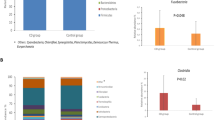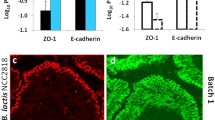Abstract
Zonulin so far is the only known endogenous modulator of intercellular tight junctions which regulate the intestinal permeability. Breastfeeding is considered to enhance the integrity of the gastrointestinal tract; however, limited data are available about the effect of feeding patterns on intestinal permeability. We aimed to investigate the potential association between the mode of feeding (breast versus formula milk) and the serum zonulin levels as a marker of intestinal permeability. One hundred fifty-seven full-term, healthy infants, born after an uncomplicated pregnancy, were enrolled within 72–96 h of life. Blood samples from 105 infants were obtained at 3 to 4 months of life. Serum zonulin levels were measured by ELISA. Out of 105 infants, 52.4% (55) were female, and 58.1% (61) were delivered by caesarian section at a mean gestational age of 38.9 (SD ± 1.0) weeks. At the time of blood sampling, median age was 3.4 (IQR 3.20–3.50) months, and mean weight was 6332 (SD ± 692) gr. Infants were divided in three groups according to the feeding patterns: exclusive breastfeeding (n = 42), mixed feeding (n = 41), and cow’s milk formula (n = 22). The feeding pattern had no impact on infants’ serum zonulin levels. Moreover, zonulin levels were not affected by infant’s clinical and epidemiological characteristics such as body weight or family history of autoimmune disease.
Conclusion: In our study, different feeding patterns were not associated with serum zonulin levels in healthy infants at 3–4 months of age.
What is Known: • Serum zonulin is upregulated in conditions with increased intestinal permeability • Breast milk favors the physiological decline of the intestinal permeability after birth in the neonates What is New: • Serum zonulin levels were not affected by the feeding pattern (breast milk versus formula) in infants at 3–4 months of age • Clinical and epidemiological characteristics of infants had no impact on zonulin levels |

Similar content being viewed by others
Availability of data and material
All authors confirm data transparency.
Code availability
N/A
Abbreviations
- CMF:
-
Cow’s milk formula
- IP:
-
Intestinal permeability
- TJs:
-
Tight junctions
References
Fasano A (2012) Leaky gut and autoimmune diseases. Clin Rev Allergy Immunol 42:71–78. https://doi.org/10.1007/s12016-011-8291-x
Sapone A, De Magistris L, Pietzak M, Clemente MG, Tripathi A, Cucca F, Lampis R, Kryszak D, Cartenì M, Generoso M et al (2006) Zonulin upregulation is associated with increased gut permeability in subjects with type 1 diabetes and their relatives. Diabetes. 55:1443–1449. https://doi.org/10.2337/db05-1593
Bischoff SC, Barbara G, Buurman W, Ockhuizen T, Schulzke JD, Serino M, Tilg H, Watson A, Wells JM (2014) Intestinal permeability - a new target for disease prevention and therapy. BMC Gastroenterol 14:189. https://doi.org/10.1186/s12876-014-0189-7
Arrieta MC, Bistritz L, Meddings JB (2006) Alterations in intestinal permeability. Gut. 55:1512–1520. https://doi.org/10.1136/gut.2005.085373
Cummings JH, Antoine JM, Azpiroz F, Bourdet-Sicard R, Brandtzaeg P, Calder PC, Gibson GR, Guarner F, Isolauri E, Pannemans D, Shortt C, Tuijtelaars S, Watzl B (2004) PASSCLAIM - gut health and immunity. Eur J Nutr 43(Suppl 2):II118–II173. https://doi.org/10.1007/s00394-004-1205-4
Fasano A (2008) Physiological, pathological, and therapeutic implications of zonulin-mediated intestinal barrier modulation: living life on the edge of the wall. Am J Pathol 173:1243–1252. https://doi.org/10.2353/ajpath.2008.080192
Fasano A (2011) Zonulin and its regulation of intestinal barrier function: the biological door to inflammation, autoimmunity, and cancer. Physiol Rev 91:151–175. https://doi.org/10.1152/physrev.00003.2008
Fasano A (2012) Zonulin, regulation of tight junctions, and autoimmune diseases. Ann N Y Acad Sci 1258:25–33. https://doi.org/10.1111/j.1749-6632.2012.06538.x
Drago S, El Asmar R, Di Pierro M, Grazia Clemente M, Tripathi A, Sapone A, Thakar M, Iacono G, Carroccio A, D'Agate C et al (2006) Gliadin, zonulin and gut permeability: effects on celiac and non-celiac intestinal mucosa and intestinal cell lines. Scand J Gastroenterol 41:408–419. https://doi.org/10.1080/00365520500235334
Walker A (2010) Breast milk as the gold standard for protective nutrients. J Pediatr 156(2 Suppl):S3–S7. https://doi.org/10.1016/j.jpeds.2009.11.021
Suzuki T (2013) Regulation of intestinal epithelial permeability by tight junctions. Cell Mol Life Sci 70:631–659. https://doi.org/10.1007/s00018-012-1070-x
Dvorak B (2010) Milk epidermal growth factor and gut protection. J Pediatr 156:31–35. https://doi.org/10.1016/j.jpeds.2009.11.018
Vukavić T (1984) Timing of the gut closure. J Pediatr Gastroenterol Nutr 3:700–703. https://doi.org/10.1097/00005176-198411000-00011
Saleem B, Okogbule-Wonodi AC, Fasano A, Magder LS, Ravel J, Kapoor S, Viscardi RM (2017) Intestinal barrier maturation in very low birthweight infants: relationship to feeding and antibiotic exposure. J Pediatr 183:31–36. https://doi.org/10.1016/j.jpeds.2017.01.013
Le Hurou-Luron I, Blat S, Boudry G (2010) Breast- v. formula-feeding: impacts on the digestive tract and immediate and long-term health effects. Nutr Res Rev 23:23–36. https://doi.org/10.1017/S0954422410000065
Weaver LT, Laker MF, Nelson R (1984) Intestinal permeability in the newborn. Arch Dis Child 59:236–241. https://doi.org/10.1136/adc.59.3.236
Weaver L, Laker M, Nelson R, Lucas A (1987) Milk feeding and changes in intestinal permeability and morphology in the newborn. J Peadiatr Gastroenterol Nutr 6:351–358. https://doi.org/10.1097/00005176-198705000-00008
Catassi C, Bonucci A, Coppa G, Carlucci A, Giorgi PL (1995) Intestinal permeability changes during the first month: effect of natural versus artificial feeding. J Pediatr Gastroenterol Nutr 21:383–386. https://doi.org/10.1097/00005176-199511000-00003
Shulman R, Schanler R, Lau C, Heitkemper M, Ou CN, Smith EO (1998) Early feeding, antenatal glucocorticoids and human milk decrease intestinal permeability in preterm infants. Pediatr Res 44:519–523. https://doi.org/10.1203/00006450-199810000-00009
Taylor S, Basile L, Ebeling M, Wagner CL (2009) Intestinal permeability in preterm infants by feeding type: mother’s milk versus formula. Breastfeed Med 4:11–15. https://doi.org/10.1089/bfm.2008.0114
Colomé G, Sierra C, Blasco J, García MV, Valverde E, Sánchez E (2007) Intestinal permeability in different feedings in infancy. Acta Paediatr 96:69–72. https://doi.org/10.1111/j.1651-2227.2007.00030.x
Moreno-Navarrete JM, Sabater M, Ortega F, Ricart W, Fernández-Real JM (2012) Circulating zonulin, a marker of intestinal permeability, is increased in association with obesity-associated insulin resistance. PLoS One 7:e37160. https://doi.org/10.1371/journal.pone.0037160
Zak-Golab A, Kocelak P, Aptekorz M, Zientara M, Juszczyk L, Martirosian G, Chudek J, Olszanecka-Glinianowicz M (2013) Gut microbiota, microinflammation, metabolic profile, and zonulin concentration in obese and normal weight subjects. Int J Endocrinol 2013:674106–674109. https://doi.org/10.1155/2013/674106
Küme T, Acar S, Tuhan H, Çatli G, Anik A, Gürsoy Çalan O, Böber E, Abaci A (2017) The relationship between serum zonulin level and clinical and laboratory parameters of childhood obesity. J Clin Res Pediatr Endocrinol 9:31–38. https://doi.org/10.4274/jcrpe.3682
Łoniewska B, Adamek K, Węgrzyn D, Kaczmarczyk M, Skonieczna-Żydecka K, Clark J, Adler G, Tousty J, Uzar I, Tousty P, Łoniewski I (2020) Analysis of faecal zonulin and calprotectin concentrations in healthy children during the first two years of life. An observational prospective cohort study. J Clin Med 9:777. https://doi.org/10.3390/jcm9030777
Galipeau H, Verdu E (2016) The complex task of measuring intestinal permeability in basic and clinical science. Neurogastroenterol Motil 28:957–965. https://doi.org/10.1111/nmo.12871
Duerksen DR, Wilhelm-Boyles C, Veitch R, Kryszak D, Parry DM (2010) A comparison of antibody testing, permeability testing, and zonulin levels with small-bowel biopsy in celiac disease patients on a gluten-free diet. Dig Dis Sci 55:1026–1031. https://doi.org/10.1007/s10620-009-0813-5
Chiba H, Osanai M, Murata M, Kojima T, Sawada N (2008) Transmembrane proteins of tight junctions. Biochim Biophys Acta 1778:588–600. https://doi.org/10.1016/j.bbamem.2007.08.017
Author information
Authors and Affiliations
Contributions
Dionisios Chrysis and Maria Triga contributed to the study conception and design. Data collection and analysis were performed by Soultana Kolyva and Dimitra Kritikou. The first draft of the manuscript was written by Soultana Kolyva and Dionisios Chrysis, and all authors commented on previous versions of the manuscript. All authors read and approved the final manuscript.
Corresponding author
Ethics declarations
Ethics approval
Approval was obtained from the ethics committee of the University General Hospital of Patras. This study was performed in line with the principles of the Declaration of Helsinki.
Consent to participate
Written informed consent was obtained from the parents.
Consent for publication
N/A
Conflict of interest
The authors declare no competing interests.
Additional information
Communicated by Peter de Winter
Publisher’s note
Springer Nature remains neutral with regard to jurisdictional claims in published maps and institutional affiliations.
Rights and permissions
About this article
Cite this article
Kolyva, S., Triga, M., Kritikou, D. et al. The effect of feeding patterns on serum zonulin levels in infants at 3–4 months of age. Eur J Pediatr 180, 3273–3278 (2021). https://doi.org/10.1007/s00431-021-04102-2
Received:
Revised:
Accepted:
Published:
Issue Date:
DOI: https://doi.org/10.1007/s00431-021-04102-2




